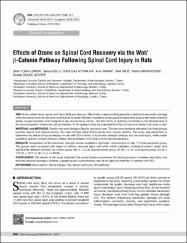| dc.contributor.author | Tural Emon, Selin | |
| dc.contributor.author | Uslu, Serap | |
| dc.contributor.author | Ilgaz Aydınlar, Elif | |
| dc.contributor.author | İrban, Arzu | |
| dc.contributor.author | İnce, Ümit | |
| dc.contributor.author | Orakdöğen, Metin | |
| dc.contributor.author | Güleç Süyen, Güldal | |
| dc.date.accessioned | 10.07.201910:49:13 | |
| dc.date.accessioned | 2019-07-10T20:04:13Z | |
| dc.date.available | 10.07.201910:49:13 | |
| dc.date.available | 2019-07-10T20:04:13Z | |
| dc.date.issued | 2017 | en_US |
| dc.identifier.citation | Tural Emon, S., Uslu, S., Ilgaz Aydınlar, E., İrban, A., İnce, Ü., Orakdöğen, M. ... Güleç Süyen, G. (2017). Effects of ozone on spinal cord recovery via the Wnt/beta-catenin pathway following spinal cord injury in rats. Turkish Neurosurgery, 27(6), 946-951. https://dx.doi.org/10.5137/1019-5149.JTN.17508-16.1 | en_US |
| dc.identifier.issn | 1019-5149 | |
| dc.identifier.uri | https://dx.doi.org/10.5137/1019-5149.JTN.17508-16.1 | |
| dc.identifier.uri | https://hdl.handle.net/20.500.12511/4016 | |
| dc.description | WOS: 000417623700014 | en_US |
| dc.description.abstract | AIM: At the cellular level, spinal cord injury (SCI) provokes an inflammatory response that generates substantial secondary damage within the spinal cord but may also contribute to its repair. Besides intracellular antioxydant increase after exactly estimated oxidative stress; oxygen formation and transport is also advanced by ozone. The Wnt family of proteins contributes to the development of the nervous system, influencing cell proliferation. In the present study we evaluated the effect of ozone on spinal cord injury in rats. MATERIAL and METHODS: Twenty-one male Sprague-Dawley rats were used. The rats were randomly allocated into three groups (control, trauma and trauma+ozone). SCI was inflicted using Allen's spinal cord trauma method. The study was performed to determine the effects of ozone therapy on rats with SCI in terms of locomotor strength clinically and neuronal injury, white matter cavitation, edema, number of blood vessels, and expression of beta-catenin immunohistochemically. RESULTS: Comparison of the locomotor strength scores revealed a significant improvement on day 7 in trauma+ozone group. The groups were compared with regard to edema, neuronal injury, and white matter cavitation. Average beta-catenin levels were significantly different between the control group (68.11 +/- 0.43), trauma+ozone group (37.96 +/- 2.16), and trauma group (25.46 +/- 1.07) (F = 1677.74, df = 2, p < 0.0005). CONCLUSION: The results of this study indicated that ozone therapy accelerates the healing process, increases vascularity, and reduces neuronal damage in rodents, suggesting that ozone therapy may be an adjuvant treatment in patients with SCI. | en_US |
| dc.language.iso | eng | en_US |
| dc.publisher | Turkish Neurosurgical Society | en_US |
| dc.rights | info:eu-repo/semantics/openAccess | en_US |
| dc.subject | Beta Catenin | en_US |
| dc.subject | Ozone Therapy | en_US |
| dc.subject | Rat | en_US |
| dc.subject | Spinal Cord Injury | en_US |
| dc.subject | Wnt Pathway | en_US |
| dc.title | Effects of ozone on spinal cord recovery via the Wnt/beta-catenin pathway following spinal cord injury in Rats | en_US |
| dc.type | article | en_US |
| dc.relation.ispartof | Turkish Neurosurgery | en_US |
| dc.department | İstanbul Medipol Üniversitesi, Tıp Fakültesi, Cerrahi Tıp Bilimleri Bölümü, Anesteziyoloji ve Reanimasyon Ana Bilim Dalı | en_US |
| dc.identifier.volume | 27 | en_US |
| dc.identifier.issue | 6 | en_US |
| dc.identifier.startpage | 946 | en_US |
| dc.identifier.endpage | 951 | en_US |
| dc.relation.publicationcategory | Makale - Uluslararası Hakemli Dergi - Kurum Öğretim Elemanı | en_US |
| dc.identifier.doi | 10.5137/1019-5149.JTN.17508-16.1 | en_US |
| dc.identifier.wosquality | Q4 | en_US |
| dc.identifier.scopusquality | Q3 | en_US |


















